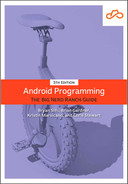GeoQuiz is up and running, but the UI would be spiffier if the NEXT button also displayed a right-pointing arrow icon.
Since Android 5.0 (Lollipop, API level 21), the Android platform has provided support for vector graphics using the VectorDrawable class. Whenever possible, we recommend that you use vector drawables to display vector graphics in your apps. Vector drawables are scalable without any loss of visual quality, so they always look crisp and free of image artifacts. And they are more space efficient than traditional bitmap images, resulting in a smaller final application.
Add a vector drawable to the project for the right-pointing arrow icon. First, select File → New → Vector Asset from the menu bar to bring up the Asset Studio (Figure 2.6).
You can import common file formats for vector graphics (SVG, PSD), but you are going to use an icon from Google’s Material icons library. They are free to use and licensed under Apache license 2.0.
For the Asset Type at the top of the Configure Vector Asset dialog, make sure the Clip Art radio button is selected. Then, click the button to the right of the Clip Art: label. The Select Icon window will pop up (Figure 2.7).
Search for “arrow right,” select the icon with that name, and click OK.
The name that the Asset Studio generates for you on the configuration dialog is verbose; rename the asset arrow_right.
Those are all the changes you need to make, so click Next, and then Finish on the following screen.
Now, expand the app/res/drawable folder in the project window and open up arrow_right.xml. Click the Split tab at the top of the editor to see the XML for your vector drawable on the left and its preview image on the right (Figure 2.8).
You will learn more about how the Android resource system works starting in Chapter 3. For now, let’s put that right arrow to work.
You use resource IDs to reference resources in code. But you want to configure the NEXT button to display the arrow in the layout definition. How do you reference a resource from XML?
Answer: with a slightly different syntax.
Open activity_main.xml.
Add the app namespace in the root element (you will learn more about this namespace in Chapter 15).
Then add two attributes to the third Button view’s definition.
Listing 2.14 Adding an icon to the NEXT button (res/layout/activity_main.xml)
<LinearLayout
xmlns:android="http://schemas.android.com/apk/res/android"
xmlns:app="http://schemas.android.com/apk/res-auto"
xmlns:tools="http://schemas.android.com/tools"
android:layout_width="match_parent"
android:layout_height="match_parent"
android:gravity="center"
android:orientation="vertical">
...
<LinearLayout ... >
...
</LinearLayout>
<Button
android:id="@+id/next_button"
android:layout_width="wrap_content"
android:layout_height="wrap_content"
android:text="@string/next_button"
app:icon="@drawable/arrow_right"
app:iconGravity="end" />
</LinearLayout>
In an XML resource, you refer to another resource by its resource type and name.
A reference to a string resource begins with @string/.
A reference to a drawable resource begins with @drawable/.
For this situation, you reference your icon with @drawable/arrow_right.
You will learn more about naming resources and working in the res directory structure starting in Chapter 3.
Run GeoQuiz and admire your button’s new appearance. Then test it to make sure it still works as before.



